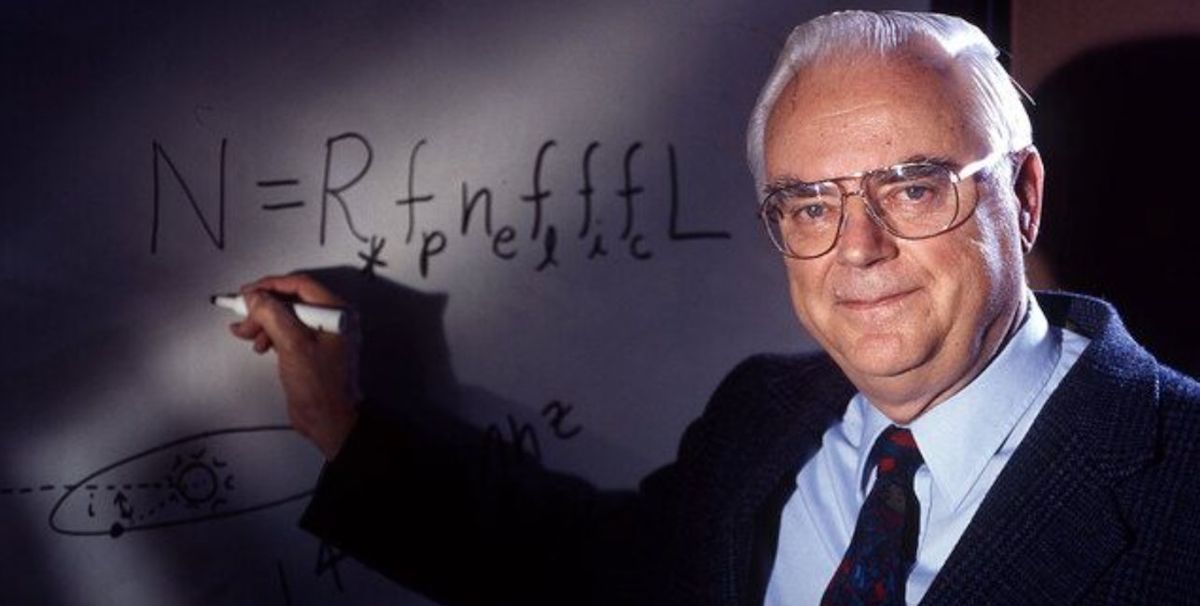Astronomer Frank Drake, who pioneered the modern search for intelligent life in the universe, passed away Friday (Sept. 2) at the age of 92.
Drake is best known for the equation that bears his name, a formula that estimates how many detectable alien societies may exist in our Milky Way galaxy. Drake devised his famous equation in 1961, a year after he initiated Project Ozma, which used a radio telescope to hunt for possible signals from extraterrestrial civilizations.
Project Ozma was a milestone, bringing new technology and a new way of thinking to the previously haphazard search for extraterrestrial intelligence (SETI). And that approach has stood the test of time.
Related: The father of SETI: Q&A with astronomer Frank Drake
“His strategy is still enthusiastically deployed six decades after his pioneering SETI experiment. This is a truly remarkable circumstance, and nearly unprecedented in exploration,” radio astronomer Seth Shostak wrote in a 2020 tribute to Drake (opens in new tab), for many years a colleague of his at the SETI Institute in Mountain View, California.
In that tribute, Shostak stressed how tough it was for Drake to blaze his trail. Drake had to battle through the giggle factor, which discouraged pretty much every other scientist from even voicing an interest in SETI.
“It was a taboo subject in astronomy,” Drake told Shostak. “Nobody else was doing a search, because they were all afraid. I was too dumb to be afraid.”
The giggle factor has been melting away recently, thanks in part to Drake and the people he inspired — several generations of astronomers, whose ranks include Shostak and Jill Tarter. Scientific discoveries have also helped pull SETI off the fringes and into the mainstream, chief among them the finds of the ongoing exoplanet revolution.
Thanks to observations by NASA’s Kepler space telescope and other instruments, scientists now know that Earth-like worlds are common throughout the universe. A recent study, for example, suggests that more than half of all sunlike stars in the Milky Way may harbor a rocky planet in their “habitable zone,” the range of orbital distances in which liquid water could exist on a world’s surface.
Given all that potentially habitable real estate and the immense age of the universe — about 13.8 billion years — it’s not crazy to surmise that civilizations may have risen beyond Earth. This realization has been percolating through academia and into the broader culture. For instance, the U.S. military has shown an increased interest in unidentified flying objects (UFOs), setting up several organizations over the past few years to investigate puzzling sky sights.
The Pentagon is not hunting for alien life, of course; it’s chiefly interested in the potential national security threat posed by UFOs. But the relatively open dialogue around the issue these days is a big change, one that Drake helped spark.
Related stories:
Frank Drake was born on May 28, 1930 in Chicago. He earned a bachelor’s degree in engineering physics from Cornell University and a master’s and a doctorate in astronomy from Harvard.
Drake was an astronomy professor at Cornell from 1964 to 1984, then held a similar post at the University of California, Santa Cruz from 1984 to 1996. He stayed on as an emeritus professor at UCSC after that. Drake also directed the SETI Institute’s Carl Sagan Center for the Study of Life in the Universe and chaired the institute’s board of trustees. Among many other distinctions and responsibilities, he was a member of the U.S. National Academies of Sciences, Engineering and Medicine, and he chaired the U.S. National Research Council’s Board of Physics and Astronomy from 1989 to 1992.
Drake stayed active in the scientific community pretty much until the end of his life. I crossed paths with him at several conferences in California’s Bay Area not long ago, for example. I was struck each time by his enthusiasm, his warmth and his friendliness. Drake certainly didn’t carry himself with the air of someone who had pioneered a field of scientific study — and that’s a big part of his legacy as well.
“My Papa D was beloved by many, and for many reasons, but above all, today I celebrate his humanity, his tenderness, his gentle spirit,” science journalist Nadia Drake wrote today in a eulogy for her father (opens in new tab) on her personal website. “A titan in life, Dad leaves a titanic absence. He was special to many of you, so on behalf of everyone whose lives he touched: We love you, Dad. You loved us, you taught us, you guided us. Ad astra, my sweet Papa D. The stars are lucky.”
Mike Wall is the author of “Out There (opens in new tab)” (Grand Central Publishing, 2018; illustrated by Karl Tate), a book about the search for alien life. Follow him on Twitter @michaeldwall (opens in new tab). Follow us on Twitter @Spacedotcom (opens in new tab) or on Facebook (opens in new tab).
